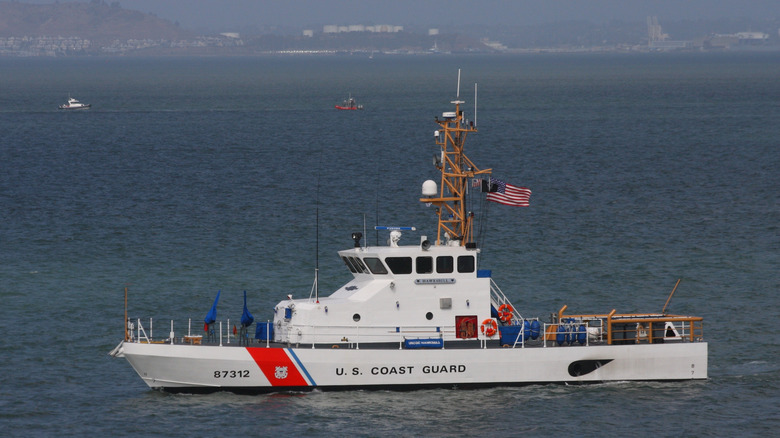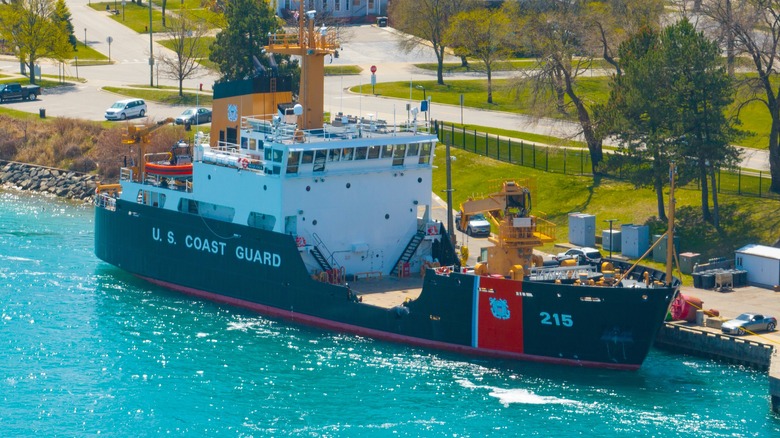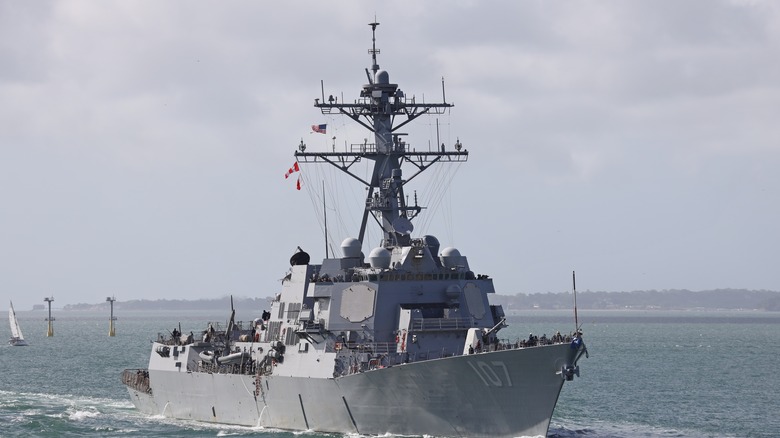Why Do Coast Guard Ships Have Racing Stripes?
Racing stripes are some of the most iconic features of racing vehicles. Part of the idea behind this eye-catching feature is exactly that: To make it as clear as possible which vehicle is which. After all, without being able to easily tell who's in which position in certain situations, there could be all manner of cases of mistaken identity. It was partially to prevent exactly this eventuality that the Coast Guard adopted its own identifying racing stripes.
The United States Coast Guard shares the story of one heroic ocean rescue in 1956, which saw the travelers aboard the Sovereign of the Skies, a Pan American clipper aircraft, adrift in the water after the aircraft's engines failed. After a Coast Guard vessel came to their rescue, Historian William H. Thiesen writes, "One survivor no sooner gained the safety of the cutter's deck, when he gratefully exclaimed, 'Thank goodness for the Navy!'"
The U.S. Navy performs a wide range of heroics itself daily, but the problem was clear: For identification purposes, as well as to foster a collective spirit and sense of identity, the public needed to be able to easily identify a Coast Guard ship when they saw one. In order to do this at a distance, in a relatively subtle yet prominent and stylish way, the Coast Guard decided that stripes on the hulls of its vessels would fit the bill nicely.
The introduction of the Coast Guard ships' racing stripes
The racing stripes of Coast Guard ships serve as important branding and help ensure that the vessels can be identified. The design, so familiar to millions of Americans and others around the world, was referred to as the Integrated Visual Identification System during its conception. The stripes were designed by Loewy-Snaith, with the company suggesting a look that (per the U.S. Coast Guard), "...should be easily identifiable from a distance, easily differentiated from other government or commercial emblems, and easily adapted to a wide variety of air and sea assets."
The service, after all, isn't just about ships. The U.S. Coast Guard flies a range of aircraft, too, and the unifying value of the Integrated Visual Identification System would be lost if it wasn't adopted by them, as well. At the same time, it would require a formality that would differentiate it from corporate logos. The final result, an attempt to combine all of these factors, was a blue and red two-stripe design, with the Coast Guard emblem of pride in place.
That emblem boasts that the U.S. Coast Guard was founded back in 1790 (originally known as the Revenue Marine), but it wouldn't be until almost two centuries later that the now-unmistakable striped design would officially be used on its fleet. The process of making it universal on all its vehicles began in April 1967.
The crucial distinction between the Coast Guard and the Navy
Being two crucial maritime arms of a country's military, there can be some crossover with the duties. Naval vessels don't typically sport the racing stripes seen on Coast Guard vessels, nor do they sport the Coast Guard's distinctive color scheme. Navy ships are gray while Coast Guard ships are painted white. This has given rise to what Coast Guard Commander Jennifer Runion described to the U.S. Naval Institute as "traditional gray-hull missions," military-inclined roles that require donning camouflage. Though some U.S. Coast Guard vessels were armed with missiles during the Cold War, they don't generally adopt a military role.
Naval vessels typically opt for darker, more understated color schemes for a stealthier, lower-profile effect. Meanwhile, the bright white and brighter colors of a Coast Guard vessel marked with racing stripes were designed with the opposite intent. It can project authority and act as an effective deterrent to those the Coast Guard may need to apprehend or pursue, while also acting as a sign of salvation for those who are stricken at sea.
In either case, the Coast Guard's presence is broadcasted. It's no surprise, then, that other nations also adopt their own take on the racing stripe. For example, the CCG-5901, the China Coast Guard's 541-feet-long patrol ship, is just one of the nation's vessels that sports a pattern of three blue stripes, a thicker red one, and a final blue stripe.


